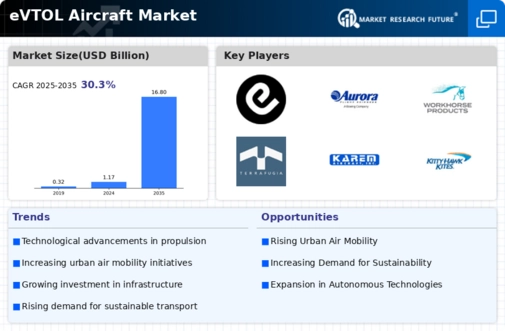Market Analysis
In-depth Analysis of eVTOL Aircraft Market Industry Landscape
The EVTOL (Electric Vertical Takeoff and Landing) Aircraft Market dynamics are propelled by a convergence of factors reflecting technological innovation, urban mobility needs, environmental concerns, regulatory advancements, and economic factors. EVTOL aircraft, also known as urban air taxis or air taxis, represent a revolutionary concept in aviation, offering electrically powered vertical takeoff and landing capabilities for short-distance urban transportation.
One significant driver of the demand for EVTOL aircraft is the increasing urbanization and congestion in cities worldwide. As urban populations grow and road congestion worsens, there is a growing need for efficient, sustainable, and time-saving transportation solutions. EVTOL aircraft offer a promising alternative by utilizing the vertical dimension to bypass traffic congestion and provide direct point-to-point transportation in urban environments. This capability addresses the last-mile connectivity challenge and complements existing ground transportation modes, offering passengers a faster and more convenient way to navigate urban areas.
Technological advancements play a pivotal role in shaping the dynamics of the EVTOL aircraft market. Innovations in electric propulsion, battery technology, lightweight materials, aerodynamics, and autonomous flight systems enable the development of EVTOL aircraft with improved performance, efficiency, and safety. Electric propulsion systems offer quiet operation, zero emissions, and reduced operating costs compared to traditional combustion engines, making EVTOL aircraft environmentally friendly and cost-effective for urban air mobility applications. Furthermore, advances in autonomous flight technology and artificial intelligence enable EVTOL aircraft to operate autonomously or semi-autonomously, reducing the need for highly skilled pilots and enhancing operational efficiency and safety.
Moreover, regulatory advancements and certification efforts drive the development and deployment of EVTOL aircraft. Aviation authorities, such as the Federal Aviation Administration (FAA) in the United States and the European Union Aviation Safety Agency (EASA) in Europe, are actively working to establish certification standards and regulations for EVTOL aircraft operations to ensure safety, airworthiness, and airspace integration. Certification efforts focus on addressing key safety concerns, including vehicle design, performance requirements, flight testing, airspace management, and pilot training, to enable the safe and widespread adoption of EVTOL aircraft for urban air mobility.
Furthermore, environmental concerns and sustainability goals shape the dynamics of the EVTOL aircraft market. As concerns about climate change and air pollution grow, there is increasing pressure on transportation industries to reduce emissions and transition to cleaner, more sustainable technologies. EVTOL aircraft offer a promising solution by utilizing electric propulsion systems powered by renewable energy sources, such as solar or wind power, to minimize carbon emissions and environmental impact. Additionally, EVTOL aircraft operations produce less noise pollution than traditional helicopters or fixed-wing aircraft, contributing to quieter and more livable urban environments.
However, challenges exist in the EVTOL aircraft market, including infrastructure limitations, battery technology constraints, airspace management, and public acceptance. Developing the necessary infrastructure, such as vertiports or helipads, for EVTOL aircraft operations in urban areas requires significant investment in planning, construction, and regulatory approvals. Additionally, battery technology limitations, including energy density, weight, and charging infrastructure, constrain the range, payload capacity, and operational efficiency of EVTOL aircraft, posing challenges for long-distance urban air mobility applications. Moreover, integrating EVTOL aircraft into existing airspace management systems and air traffic control procedures requires collaboration between aviation authorities, urban planners, and industry stakeholders to ensure safe and efficient airspace utilization and integration with other airspace users.









Leave a Comment